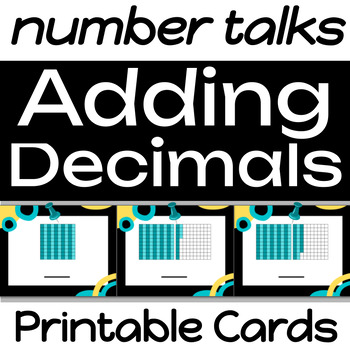Adding Decimals: Pattern Number Talks (PRINTABLE)
- PDF
Also included in
- Pattern Talks are an easy 10-minute a-day routine to help students master fourth grade math standards. Get your students engaged in their math this year with this enriching, easy-to-use math routine, and watch the conversations blossom!Card sets in BOTH NO-PREP GOOGLE SLIDES AND PRINTABLE VERSIONS iPrice $25.00Original Price $39.82Save $14.82
Description
A Pattern Talk is a daily number talk routine using printable pattern cards. Each card adds the same mystery number (decimal addition). Students analyze patterns on the hundreds grids to discover the addend and add decimals to predict the next cards. Perfect for morning meeting, calendar time, or math warm-ups. Use as a pre-teaching or review activity!
Product Description:
You will receive a PDF with instructions for use and 12 pages of cards. There are two half-sheet-sized cards on 6 pages, as well as half-sheet-sized card backs on an additional 6 pages. There is an answer key included on the final slide for teacher reference. Cards perfectly align when printed double-sided. Cards should be displayed so the whole class can see and discuss them - in a number corner or under the board, for example.
Each day, students are asked to follow the 3-step Pattern Talk process:
- Predict the next card in the sequence
- Find the total displayed on the hundreds grids
- Analyze and discuss patterns across the entire set of cards to find the mystery addend
Why Use Pattern Talks?
Each card in this series uses a hundreds grid model to depict decimal values and to model decimal addition. Each day, the total increases by 0.14, but your students don't know that! They will work together to analyze patterns across cards and discuss their observations to come to a class consensus on the mystery decimal addend. Once they figure it out, they will put it to use predicting the next cards in the sequence! The decimals in this talk are always given in simplest form (e.g. instead of 1.70, we write 1.7). The hundreds grids are color-coded to help students recognize both hundreths and tenths on the same grid, and to recognize the equivalence between tenths and hundreths. The cards begin with decimals less than one whole and progress to decimals greater than one whole, adding more place values as the talk progresses. Students will readily draw parallels between the base ten addition they have done with whole numbers, and the process for adding decimals. A great opportunity to spark class discussion about decimal addition!
More teachers are using Pattern Talks in their classrooms because they are...
- Quick and easy! My students often walk away with more learning after this 10-minute-a-day classroom discussion than from our formal math lesson.
- Are engaging! All students are invited to think, participate with manipulatives, share their thinking, agree/disagree with classmates, and ask each other questions!
- Increase in complexity. Pattern Talks scaffold students as they move from simpler more accessible problems to more challenging ones.
- Make learning accessible. Pattern talks repeat the 3-step process, providing a routine that makes it easier for all students, including ELLs, to engage. Students who were not ready to share their ideas yesterday might try out strategies others have shared, and find success today! Pattern Talks provide enough time for everyone to learn and share their success!
Other Resources You Might Like:






